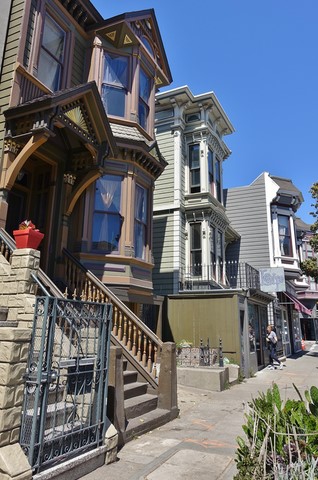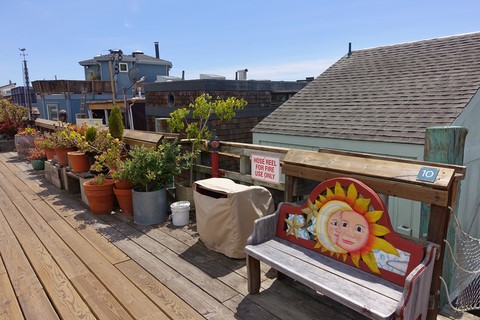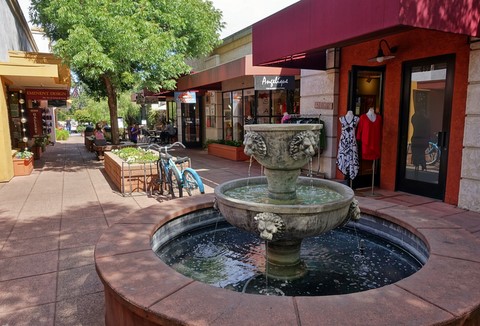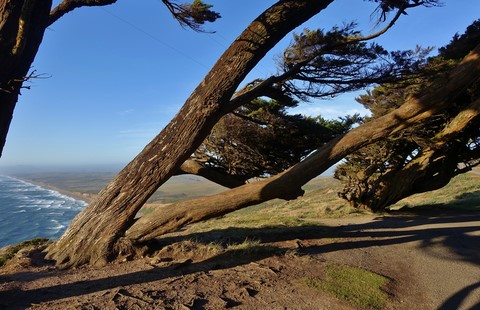Northern California
You can click on pictures to enlarge them
San Francisco
We have been caught from the first moments by the incredible atmosphere of San Francisco. It is the effect it has on many visitors who discover it and fell in love with it at first sight. It is like it had too many wonders to reveal, too many exciting things to tell us. Its history was both tormented and rushed, but constantly carried by an unwavering optimism and an everlasting desire to move forward. Its diversity is all the more remarkable that it is a human-sized city. Cosmopolitan, open-minded, tolerant, exuberant, innovative... it is attractive in many ways.
Built on some forty hills, we do not hesitate to pace up and down its steepest streets, for we know that no matter what the direction we take, we will have quickly a bird's eye view of one of its sites or monuments known throughout the world: the must-see Golden Gate Bridge, the very colored Painted Ladies, the iconic cable-cars, the beautiful and winding Lombard Street, the former Alcatraz penitentiary perched on an island in the middle of the bay... many idealized images seen over and over on TV or in movies theaters, and that we marvel at during our first stay in that mythical Californian city. Then, we understand why it is so fascinating.
On our very first days, we stayed in the SoMa (South of Market) district, which known years ago a real renewal, notably with the establishment of museums. It was then very fashionable, with its trendy restaurants and its very appreciated nightclubs, but it starts now to lose ground to the benefit of other districts. Indeed, we did not find the area so bustling as we were leaving our hotel after the check-in. However, we had a foretaste of the indefinable atmosphere of San Francisco, its diversity and its open-mindedness. And above it all, we felt immediately that pleasant sense of well-being.
Then, we reached the Embarcadero and its numerous piers in the bay. The whole is overlooked by the superb Ferry Building and its blue spire with a clock. The very impressive Bay Bridge - the other suspension bridge of San Francisco - stretches over more than 13 kilometers to join Oakland. The place is very pleasant, and we felt love at first sight from the moment we came there. The long promenade, the covered market (Market Place), the farmers market and its high-quality restaurants draws cheerful crowds of people who take the time to live. Others practice biking, footing or roller while enjoying a privileged view of the bay. Some streets performances also take place there. All of that happens in contagious good mood.
We ended with the must-see Fisherman's Wharf, especially Pier 39: it is the most touristy place in the area. There, seals, eared seals and sea lions do the show for young and old alike in front of the former Alcatraz penitentiary, isolated on its island with steep cliffs, and with the Golden Gate Bridge on the background. The attraction was extraordinary, and hilarious at times. Overall, we had very positive vibes during those few hours spent in the Embarcadero: striking encounters, moments of happiness or giggles, and above it all that joy of living the city exudes, and which catches us from the first moments. Then, we understood that we would remain attached to San Francisco forever. It was already part of our favorite cities.
The day after, we carried on with Downtown, the historic center in the middle of which Union Square offers department stores and luxury shops, exhibitions, show dances and concerts. Civic Center groups together the various administrations, among others the City Hall, Fine-Arts style building which reminds inevitably the famous Capitol in Washington. The Theater District is - as the name suggests - dedicated to art. It enjoys picturesque rooms, and others that are more modest but are nevertheless worth visiting.
The most beautiful was yet to come, with the sumptuous colored multistoried Victorian houses in Queen Anne style in the Hayes Valley and Haight districts. We took the long Hayes Street, where houses surrounded by beautiful small gardens proudly display their very typical bow-windows, their access stairs and their stoops that follow one another into a splendid perspective as far as the eye can see. Some of them are even provided with Corinthian columns. A French-style bakery stands in the intersection with Octavia Street. Haight is known for being the birthplace of the Summer of love. It kept undeniable sweetness of living and carefree life. Restaurants and shops there have a special character. Parks are very pleasant, notably Alamo Square in front of the very famous Painted Ladies, those seven Victorian houses with different colors in a row which are one of the idealized images of San Francisco. Unfortunately, it was under construction during our stay and we could not have access there.
We made up for it with the superb and huge Golden Gate Park, often compared to Central Park in New-York. The arboretum and the Conservatory of Flowers are beautiful, as well as the Japanese Tea Garden and its very nice pagoda. Stow Lake is a haven of peace that appeals to you thanks to its splendid bridges, its very colored Japanese kiosk, and its fall around which some hummingbirds come to gather on flowers. Finally, a Dutch windmill stands in the western part of the park, close to the seashore.
We reached the coast in Baker Beach, where the waves of the Pacific Ocean were breaking. From there, we could admire the mythical and impressive Golden Gate Bridge that displayed its slender outlines, which coral color contrasted beautifully with the deep blue of the water. We took the time to contemplate from the distance that jewel of Art Deco architecture built in the 1930's, before we reach it taking the California Coastal Trail that runs along the cliff and offers a breathtaking view. We made a stop at a very close viewpoint, and then we finally reached it to cover nearly half of it on foot. Then we were able to appreciate its hugeness, and we felt indescribable sensations. Strong winds were blowing there, and we could feel the vibrations caused by the numerous motorized vehicles taking it. We crossed it by car at our journey's end to reach Sausalito, Wine Country and Point Reyes. Sensations were different, but just as intense. On our way back at night, we took it a last time to get back to San Francisco. As we were parking at its exit, we were fortunate to get close to a raccoon that was just here and to observe it for a few minutes.
The picturesque Chinatown is the first Chinese district in America, moreover the nicest and surely the biggest, even though New-Yorkers also claim that title for their own Chinatown. Very exotic, its typical decor carried us away to another continent and to another time. The beautiful and colored Dragon Gate, covered with green tiles, is a real masterpiece. In the small Ross Alley stands the Golden Gate Fortune Cookie shop, where are made those famous cookies that contain a message.
When we returned in San Francisco for the three last days of our trip, we went to Nob Hill and Russian Hill, two very steep hills at the origin of the creation of the cable-car and its unique in the world mechanism in the late 19th century, which stood out as a necessity. The passage of those vehicles constantly overcrowded is part of the local folklore and arouses fervor and wonder for the closest passers-by. We could not resist the temptation to take the worldwide known Lombard Street with our rental vehicle. Winding and sloping, its bends enter fresh armfuls of hydrangeas, the whole in front of nice colored town houses. The bird’s eye view of the bay is vertiginous, and the sensations we had were intense.
The day before we left, we visited the south-west of the city, starting with the Twin Peaks, two hills that rise at the edge of town. They offer a breathtaking view of San Francisco and its bay. We returned via Castro and Mission District (photo). Castro, the gay district, is very pleasant and known for its bustling nightlife. Its Victorian houses, more modest than those of Pacific Heights, are nevertheless splendid. As for Mission District, it is the lesbian district. It owes its name to the San Francisco d'Assis Mission - oldest building in town - built on the late 18th century. It is really appreciated by artists and bohemian youth. It has traditionally a Latin identity, even though the latter has declined a little bit over the years. Dolores Park, the green lung in the district, is very pleasant and people like to come there and have a good time, especially on weekends.
In the end of the afternoon, we went back to Lombard Street to take it on foot that time, taking naturally more time to admire the bird’s eye view. Then, we went down to North Beach, birthplace of the Beat Generation, famous movement of counterculture from the late 1940’s. We crossed the pleasant Washington Square, in the surrounding of which rises Saints Peter and Paul Church, to reach the district of Telegraph Hill, hill with very steep streets on top of which the Coit Tower - remarkable Art Deco building - seems to go on guard in all its majesty. Its top offers an unrestricted view of the city and the bay. Unfortunately, we came too late to have access there, so we contented ourselves with admiring it. Finally, we took the Filber Steps that rush into a narrow jungle with splendid hanging gardens. In their setting appeared charming small colored houses. Rhododendrons, bougainvillea, jasmine, fuchsias and roses exhaled their heady scent. We could hear some wild parrots perched on trees. After they carried us away to one of the most exotic places in town for a while, those steps on the hillside led us to the Embarcadero, where we fell in love with San Francisco three weeks sooner. The circle was complete.
There, we sat on the terrace of a bar to have a Budweiser while admiring for a last time the bay that opened to us. We felt good. We talked about that unforgettable trip that was coming to its end, past trips and future trips. And above it all, we talked about our love for that city, already convinced that we would come back as soon as possible. Dreams, plans, memories, the desire of enjoying the moment, it was all there. That moment was perfect.
San Francisco is part of our favorite cities. To have access to the section, click here
San Francisco Bay
Berkeley is above all famous for its university, one of the most prestigious in the U.S.A. There, you will find the same sweetness of living and the same open and casual mind as in San Francisco, the whole tinged with a carefree life inspired by a cosmopolitan student population. It was also motivated by an anti-establishment mind in the 1960’s, when there was a stirring of revolt named Free Speech Movement in the campus. They had mainstream values, a too fixed system, and above all the very unpopular Vietnam War in their sights.
So, we visited the UC Berkeley Campus for our return in San Francisco at the end of our trip. The Sather Tower, iconic building inspired from the bell-tower of San Marco Square in Venice, proudly rises to overlook the place. The wide lawns, some of which are shaded, tempt to idleness and you immediately feel like lying on it to immerse yourselves in the student life. Many buildings are in Art Deco style. The guided tour by volunteer students turns out to be very instructive.
Located east of the bay, the town is dominated by mounts that give it an additional attraction, and taking a walk there is very pleasant. Restaurants are high quality. Some of its bars offer live music. Its museums are worth visiting, notably the University Art Museum and the Lawrence Hall of Science. The UC Botanical Garden is very vast and very varied. If you like fresh local products, some of which are organic, the Andronico’s Community Market was made for you. There is a broad choice and you may not leave empty-handed.
The name of Oakland is inevitably associated with that of the famous writer Jack London, who was born and lived there most of his life. Besides, one of the main squares of the city bears his name. Located below Berkeley, it is connected to San Francisco by the Bay Bridge, impressive 13 kilometers long suspension bridge. Its architecture is very rich. Art Deco is much represented, often at its best, like the Paramount Theatre or the Magnin Building. However, other styles are not forgotten, like Fine-Arts, Moorish and the must-see Victorian houses in the Old Oakland historic district. Its Chinatown, naturally less picturesque than that of San Francisco, is nevertheless authentic. Like in Berkeley, there are very good restaurants and very vivid live music bars.
Located north of the bay, Sausalito (photo) is connected to San Francisco by the very famous Golden Gate Bridge. Victorian houses and more modern houses perched on the hills overlook the marina and the houseboats, those lovely very colored floating homes. They are adorned with various decorations that compete in imagination and diversity, as well as the small gardens surrounding them. Very pretty, they are the main attraction in town and that district exudes a very bohemian atmosphere. Nice wooden houses, trendy shops, cafés, restaurants and art galleries complete the picture of that very charming and very peaceful small town where happiness flows.
Wine Country
Located an hour drive north of San Francisco, the Wine Country is a beautiful region. The place is very wild and vineyards cover hillsides as far as the eye can see. Wine chateaux proudly rise there. Some of them, with their slate knee roofs, remind naturally France. Contrary to prejudice, grape varieties and wines are high quality, and there are even organic wines. So feel free to make a stop at a property for a visit and a wine-tasting.
Napa Valley is the most famous of wine regions, so much so that it is the victim of its own success. Indeed, tourism has increased there in places, with some drawbacks. It is therefore preferable to avoid if possible busy days, and to favor small mansions, more authentic and less popular. Then, you will be able to take your time. Many ways to discover it are offered: balloon, small old steam train, Jeep or limousine. If you take your own vehicle, favor the Silverado Trail, more pleasant and less traveled than Route 29.
The small town of Napa manages to remain authentic, witness its Napa Mill historic district that is worth a walk on its own. The other attraction is the Oxbow Market, which offers a farmers market, a grocery, bars and restaurants. Residential areas are full of imposing Victorian houses surrounded by lush gardens. Their bow-windows, porches, verandas and turrets compete with beauty. Uptown, its Art Deco theater, is splendid. Not far stands a superb mural that depicts Amerindians devoting themselves to gathering.
Sonoma Valley (photo) is much prized by San Franciscans, especially on weekends, for it is the nearest wine valley. As in Napa Valley, it is preferable to take the charming country roads rather than the main roads. That may take you more time, but you will cross idyllic landscapes. You will also find more interesting mansions, even though they have generally less to offer than those in Napa Valley.
Few people know, but California has been a fully-fledged republic… for 25 days!.. It all just began in the town of Sonoma in the mid 19th century when Americans rebelled against the Mexican government and claimed their independence. It was called the Bear Flag Revolt, in reference to the flag with a bear on that was raised on the central square. However, that brand new republic was quickly incorporated into the U.S.A. As for the flag, it was kept to finally become that of the California State in the early 20th century.
The town was built around the last of the 21 Spanish missions in California: San Francisco Solano de Sonoma. Its Old Town center is an architectural gem, notably the Sebastiani Theatre. It abounds in shops and restaurants, and the place is so pleasant that your find yourself lingering there longer than you thought. Big wooden doors open to beautiful patios.
Point Reyes National Seashore
That extremely wide and preserved park is located north of San Francisco, on steep cliffs where nature is almost constantly swept by incredibly strong winds. Dried grass is bent onto the floor. The closest trees to the shore are unbelievably inclined, as if they were about to creep. But contrary to what we could think in view of those climatic conditions, fauna there is very rich. We had notably the opportunity to see Tule wapitis - or dwarf wapitis - moving with remarkable ease on the cliff-side.
You can see Point Reyes Lighthouse down below from a viewpoint. It is open to visitors for those who have the courage to take the more than 300 stairs. Unfortunately, we came late in the afternoon and it was closed. It seems solitary and abandoned, but it gives to that landscape cut off from the world additional life.
Published on October, 28th 2017







